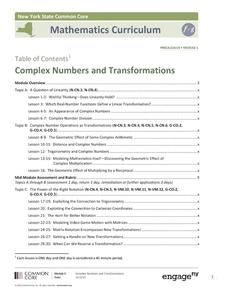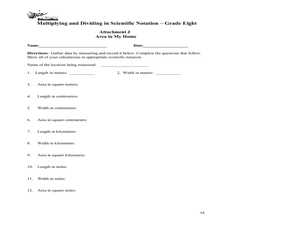Curated OER
Dividing by Negative Powers of Ten (C): 2-Digit Facts
In this math worksheet, students are given 10 numbers which they are to divide by 1, .1, .01, .001 and .0001. Once the procedure is understood, the answers are easy to find.
Curated OER
Dividing by Positive Powers of Ten (A): Single-Digit Facts
In this math worksheet, students are given 10 numbers which they are to divide by 1, 10, 100, 1000, and 10,000. Decimals are used in the answers.
Curated OER
Dividing by Positive Powers of Ten (A): 2-Digit Facts
In this math worksheet, students are given 10 numbers which they are to divide by 1, 10,100, 1000, and 10,000. The answers are decimal numbers.
EngageNY
Complex Numbers and Transformations
Your learners combine their knowledge of real and imaginary numbers and matrices in an activity containing thirty lessons, two assessments (mid-module and end module), and their corresponding rubrics. Centered on complex numbers and...
Curated OER
Sudoku Puzzle: Logs and Exponentials
In this logarithms and exponential learning exercise, students solve 29 multiple choice problems. Students use their answers to solve a sudoku puzzle.
Curated OER
Numerical Analysis
In this math learning exercise, students practice converting binary numbers from one base to another. Then they read the related vocabulary definitions.
Curated OER
Quick Quiz: Multiply and Divide with Fractions and Decimals
Here is a fraction and decimal worksheet in which learners solve eight problems that require them to multiply and divide using fractions and decimals.
Los Angeles County Office of Education
California State Standards: Algebra I
Starting a year of Algebra I? This mighty packet practices all of the major topics with different ranges of difficulty. Standards include everything from linear to quadratic to rational expressions. Use it in a variety of ways to...
Illustrative Mathematics
Exponentials and Logarithms I
This task focuses on using the verbal definition of the logarithm to understand that a logarithm is an exponent. Learners complete six computational exercises using the inverse properties of logs and exponents and answer two discussion...
Mathematics Vision Project
Module 2: Linear and Exponential Functions
Write, graph, and model all things linear and exponential. Building on the previous module in a nine-part Algebra I series, learners compare linear exponential modeling. They write equations, graph functions, and analyze key features.
EngageNY
Magnitude
Build an understanding of the powers of 10. Pupils investigate the results of raising 10 to positive and negative powers. They relate this understanding to the magnitude these powers represent in this seventh lesson of 15.
Illustrative Mathematics
Exponentials and Logarithms II
Learners are given a logarithmic function and its inverse exponential function. The task, which is to graph both compositions of the two functions, uses the inverse nature of exponents and logarithms to generalize about the properties of...
Curated OER
Fast Growing Plants
Negative exponents can be tricky, but this resource makes a mathematical conundrum an easier concept to grasp by relating the concept of exponents to the amount of time a plant has been owned. Fifth, sixth, and seventh graders will enjoy...
Ohio Department of Education
Multiplying and Dividing in Scientific Notation - Grade 8
Here is really nice set of resources on scientific notation. Eighth and ninth graders explore the concept of multiplying and dividing in scientific notation. In this multiplying and dividing numbers in scientific notation instructional...
EngageNY
Modeling with Exponential Functions
These aren't models made of clay. Young mathematicians model given population data using exponential functions. They consider different models and choose the best one.
Code.org
Public Key Cryptography
Investigate how public key cryptography works. Scholars continue their study of one-way functions and asymmetric keys and apply this information to public key cryptography. They use an app to explore public key cryptography and its...
Curated OER
Numerical Analysis: Machine Representation of Numbers
In this machine representation of a number learning exercise, students explore definitions such as floating-point, round-off error, binary representation of a number, mantissa, and sign bit. They identify significant digits and...
Curated OER
Times Tables Questions
For this multiplication worksheet, students solve 10 problems in which a multiplication problem is presented in words. Students then solve 10 problems in which a number (shown with an exponent of 2) is multiplied by itself.
Robert Gordon University
Indices
The laws of exponents are written on a handy reference sheet. Note that since this worksheet was written in the UK, powers or exponents are also called indices (singular: index). If this does not pose a problem for you, the concepts and...
Curated OER
Worksheet #6, Exponents, Interest, and Radioactive Decay of Isotopes
For this calculus worksheet, students sketch graphs of given exponential functions. They compute the principal needed to have a given ending balance when the interest is compounded at varying times. Students use a simple exponential...
Curated OER
Division of Monomials
Students relate the division of monomials to multiplication. For this division of monomials lesson, students divide monomials by factoring and dividing common factors from the originals. They check their answers by multiplication. As...
Curated OER
Complex Analysis: Polar & Exponential Forms
In this polar and exponential form worksheet, students use Euler's Formula to write complex numbers in exponential form. They write numbers in rectangular form. This two-page worksheet contains seven multi-step problems.
Curated OER
Homework 7: Hares and Foxes (Based on a problem in Cic)
For this system of equations worksheet, students use systems of equations and Euler's method to calculate the population of hares and foxes. They plot and interpret their results. This one-page worksheet contains three multi-step...
Curated OER
Empirical Probability
In this empirical probability learning exercise, 8th graders solve 10 different problems related to determining the probability of a number. First, they determine the probability of selecting a letter other than a consonant. Then,...

























